
Book Illustrations, page 2
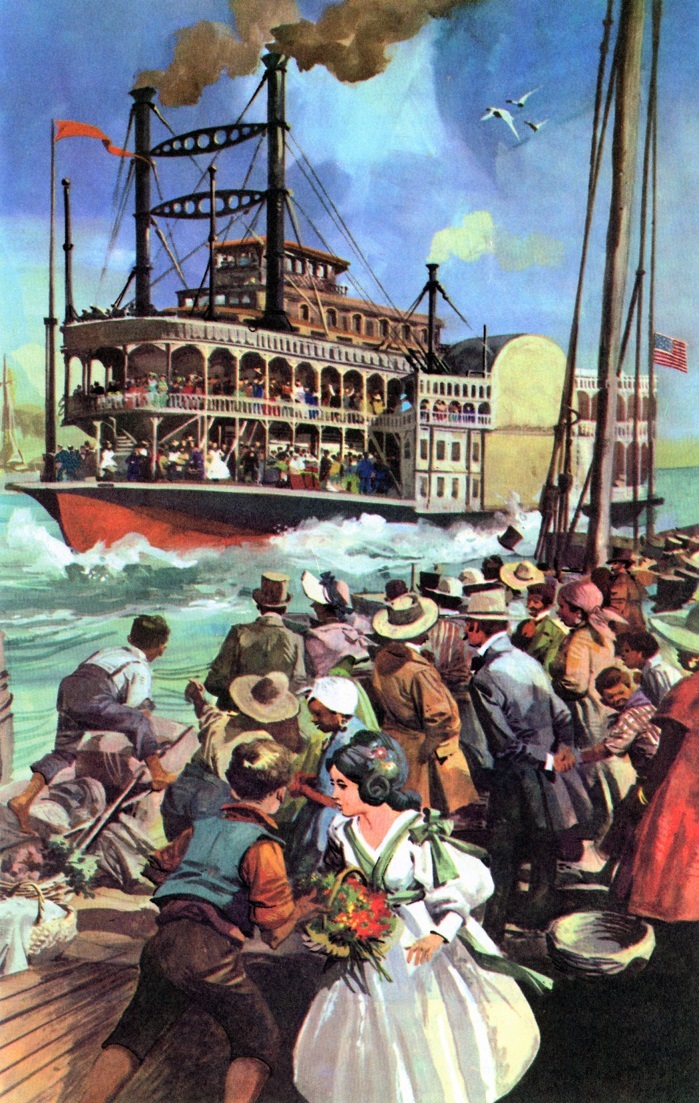
Steamboat illustration from unknown history book
Attached page from an unknown, undated and uncredited simplified U.S. history book, presumably written for "young readers."
On the back of this page featuring an illustration of a steamboat probably arriving at New Orleans with onlookers on the wharf in the foreground is text about "The First Americans" (Indians/Native Americans) and mention of "Custer's Last Stand."
The page came all the way from Australia but the eBay dealer did not mention the title of the book and it's possible it was published for young students of history in a country other than the United States.
From the style of the artwork this painting could have dated anywhere from the late 1940's to the mid 1960's.
The pilot house on the texas deck between the 'stacks is elongated which is "off model" since they typical pilot house would have been more "cube shaped"—square in proportion on both sides & front & back. Also the pilot house and texas appear to be unpainted wood rather than painted white which was the traditional motif.
The "spandrels" between the stacks are a bit heavy and would have been more delicate and lightweight in design.
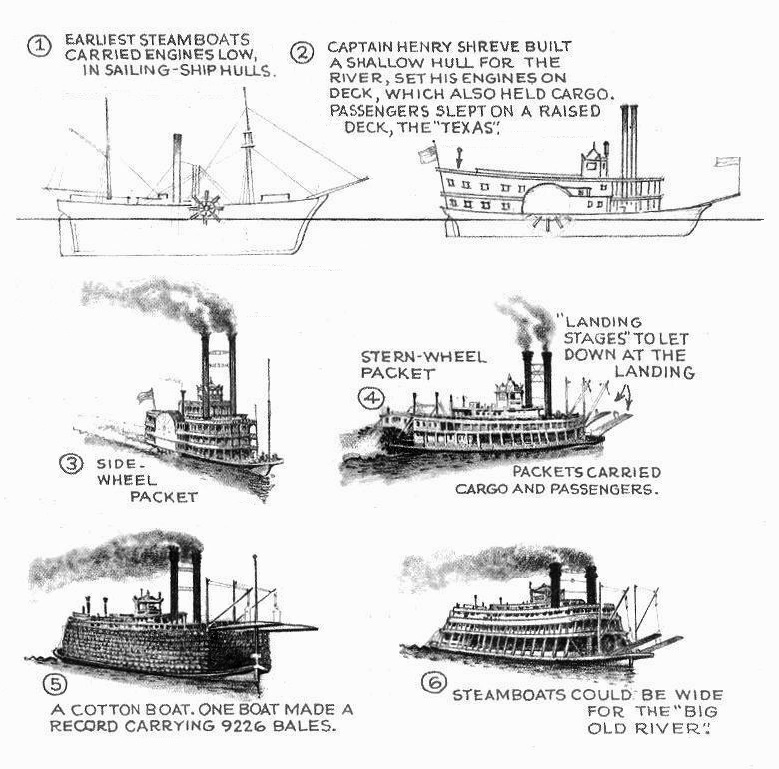
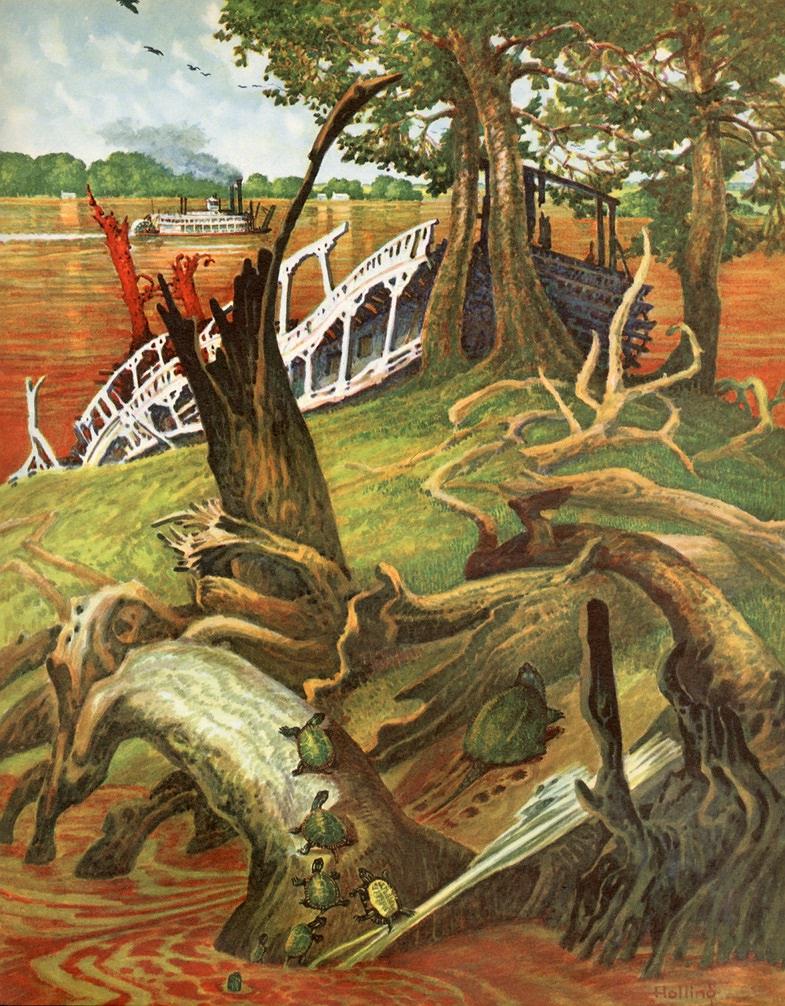
Holling C. Holling illustration from MINN of the MISSISSIPPI
All the illustrations are beautiful and in the margins of the pages with text on them are sketches by Holling on an infinity of subjects such as nature including fish, fowl and other wildlife. History of Native Americans and explorers expeditions and of course all manner of floating craft including flatboats, keelboats, shanty boats and of course steamboats that carried passengers and the U.S. mail and towboats that pushed barges with every sort of cargo. People who lived along the shore past and present are included. Very worthwhile book to get and in soft cover reprints, very reasonable or you can find hardcover early editions, including the first from 1951. The first copy I read and pored over the illustrations in came from the public library until I found a second hand copy for my very own. Attached is my favorite of the color illustrations which include steamboats. Page 66 has text and Holling's educational sketches of steamboats. File a bit large for your posting and I can check on whether this one can stand reduction or not, or I can isolate the sketches and montage them together to take up less space and transcribe the text which would take up a lot less space if included in the caption.
The perfect review on Bill Ectric's site "Literary Kicks" below:
Minn of the Mississippi
by Holling Clancy Holling
Houghton Mifflin Company, 1951
First Edition. 85 pages
Holling C. Holling's text for page 66 was accompanied by sketches of early steamboats. (above)
"Yep, 'twas 1811 that changed things. Plenty! Some folks up at Pittsburgh had whanged out an iron kettle, all crawling with pipes; wrestled it into a boat; set a fire under it. A sane man would have bet that fool boat would blow to thunder! Yet she could spank herself upstream! And she traveled Ohio and Mississippi, out-whooping loudest Injuns and keelboatmen! Oak-tough pole-men sure hated like poison to admit that horny hands, leather lungs, rawhide sinews were beat by hatfuls of wispy STEAM!
STEAMBOATS changed the rivers — planted new towns, and people. Like keelboats, they had their days of glory. Then came "steam cars." Now other cars, rolling on rubber, coax old steamboat towns to new highways, back from the waterfront; while all-steel TOWBOATS, with "screws" and no paddle-wheels, push barges instead of towing! Seems like the world's been crazy since 1811, when that first steamboat hit the River!
Yep, Ole Mississip sure went crazy that year! New Madrid Earthquake, worst in U.S. history, rocked the frontier. Lightning flashes, choking sulphur fumes, thundering roars, folks screaming, fowls screeching, cattle bawling — seemed like the end of the world! There were cabins crumbling, folks dying, earth-cracks gaping and swallowing things. Tree-rows leaned back, whipped over, crashed down — and the billows rolled through forests, across solid fields like waves on the liquid sea. . . .
And the River? It sucked itself dry from banks and bed, pulling itself apart. It slammed tons of barges on bare river bed at New Madrid, and the crews ran for shore on sand bottom. Some made it — but the River came back, twelve feet tall, to scoop the wrecks under and race uphill for whole minutes. New Madrid sank some fifteen feet. The earth shuddered, off and on, a couple of years. Even cows got used to staggering. The crazy river had made big Reelfoot Lake, south of Hickman, where no lake was before. That steamboat? Slid down to New Orleans in safety. Old Injuns said its bad magic made the quake! Howsomever, steamboats did change the River. . . .
Minn, swimming among her sunken staterooms like a serving platter carried by unseen hands, did not know that the long-ago earthquake had heaped her sand pile."
litkicks.com/Holling
LITERARY KICKS
Minn of the Mississippi: On the River
Bill Ectric • June 6th, 2004
Long before my young attention span could handle reading the entire text of this book, I sat for hours pouring over the fascinating illustrations. Minn of the Mississippi, by Holling Clancy Holling, left a lasting impression on me. It wasn't as easy to read as The Cat In the Hat, but the detailed panoramas of river life, tugboats, floods, peaceful dark swamps, all told the story like a good movie that I could watch over and over again with the turning of pages. Eventually I did finish the entire text -- a landmark in my progress as a young reader. Recently, upon reading it again, was I impressed with the idea that this book is like the turtle version of On the Road.
The story begins way up in the North Woods of Minnesota. Minn is the name of one baby turtle which hatches from a group of turtle eggs. All the baby turtles scurry for safety as a crow swoops down, looking to make a meal of them. Just then, a hunter fires a rifle at the crow. The bullet nicks the crow's tail feathers and cuts off Minn's left rear leg. The crow flies away, scared by the rifle. The baby turtles, including the injured Minn, instinctively run from their sandy nest, plop into the water, and hide themselves by digging down into the silt of the river bottom.
Minn recovers from the wound and begins an amazing twenty-five year adventure which takes her down the entire length of the Mississippi River through several states, past river towns and cities, struggling over and under dams, captured on boats for a time, witnessing floods, encountering both humans and animals which are sometimes friendly and sometimes dangerous, laying eggs along the way, until at last she reaches the Gulf of Mexico. The Gulf being too salty, Minn settles nearby in a New Orleans bayou with the help of some friendly fishermen.
The story ends with a message, or moral. Over the years, as humans were striving for wealth and possessions, the power of the river remained constant and just barely tamed by man's technology. The riverbed where Minn now lives is covered with coins, gold treasures, rubies, diamonds, and emeralds, all from sunken ships of past pirates, businessmen, and riverboat gamblers. Did these riches mean anything to Minn the turtle? Holling writes:
Thus Minn lived on a glittering heap ... of what? Rich jewels, once more, were merely stones; and one of the earth's heaviest elements, melted neatly into golden wafers of equal weight ... was returned again to the care of earth and water. For Minn, her doorstep of so-called treasure was only a hardness, like water-worn pebbles.
Holling Clancy Holling wrote and illustrated several children's books which have been used often by teachers to help kids learn about geography, history, zoology, and and anthropology. These books include Paddle-to-the-Sea (1941), Tree in the Trail (1942), Seabird (1948), Minn of the Mississippi (1951), and Pagoo (1957). He did a lot of research to make sure his books were accurate. Sometimes his wife, Lucille, helped with the illustrations.
Holling was born in Michigan on August 2, 1900. He graduated from the School of the Art Institute in Chicago in 1923 and became a member of the zoology department at the Chicago Museum of Natural History from 1923 to 1926. He and Lucille Webster were married in 1925. Before becoming a full-time writer, Holling also worked as a teacher for New York University, a freelance designer, an advertising artist, and an illustrator for other people's books. Mr. Holling died on September 7, 1973.
I would like to conclude with another quote from the book. This is the part where Minn the turtle passes through New Orleans, much of which is below sea level. I really like how Holling describes it:
"New Orleans is a cooking pan, a laughing face and a rhythm. A soft humming runs down its levees like rain-trickles of sound. It comes from houses, mansions, shops and skyscrapers; from dark alleys and day-bright boulevards; from people working and people at play; from feet hissing on dance floors, from hands beating, from singing mouths; and the rhythm is cradled in crooning strings, a moaning of the trumpets, drums sobbing ... And some of the rhythm has jungle in it; it tells of other rivers, crocodiles, long cats and shadows of elephants?And as Minn went by, drums talked this New Orleans rhythm into the river night ..."
Minn of the Mississippi was one of my favorite books as a child, and still is.
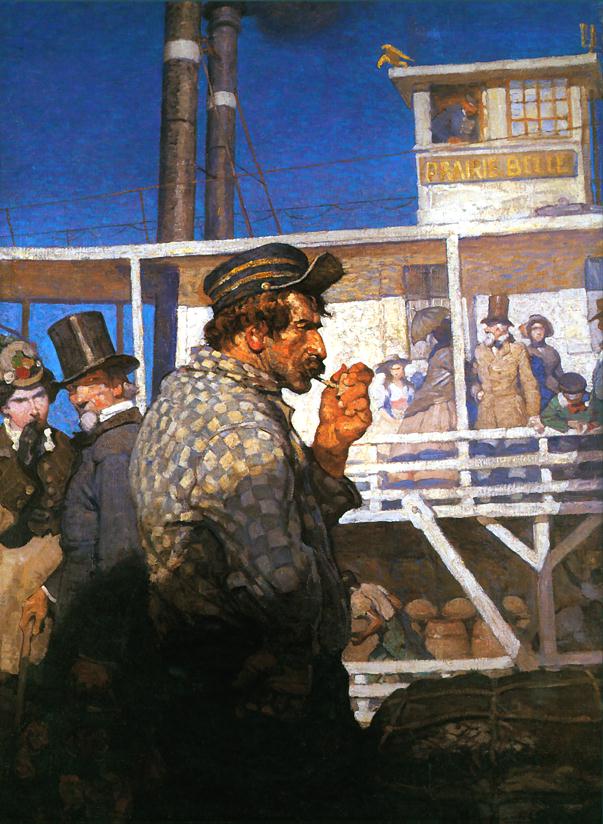
An illustration of Jim Bludso of the Prairie Belle by celebrated American artist N. C. Wyeth (1882-1945) for one of John Hay's PIKE COUNTY BALLADS. Published by Houghton Mifflin Co., 1912.
These lines from the poem give you a capsule description of Engineer Jim Bludso's creed:
"And this was all the religion he had,
To treat his engine well; Never be passed on the river;
To mind the pilot's bell; And if ever the Prairie Belle took fire,
A thousand times he swore. He'd hold her nozzle agin the bank
Till the last soul got ashore.
All boats has their day on the Mississip,
And her day come at last, The Movastar was a better boat.
But the Belle she wouldn't be passed."
John Hay (1838 - 1905) was raised on the Mississippi in Warsaw, Illinois which is 57 miles due north of Sam Clemens' Hannibal, MO. Hay was one of Abe Lincoln's two private secretaries in D.C. during the Civil War. From 1898 - 1905 Hay was Secretary of State. Hay praised Mark Twain for capturing the atmosphere of Hannibal as a typical rivertown in the 1840's and '50's in LIFE ON THE MISSISSIPPI.
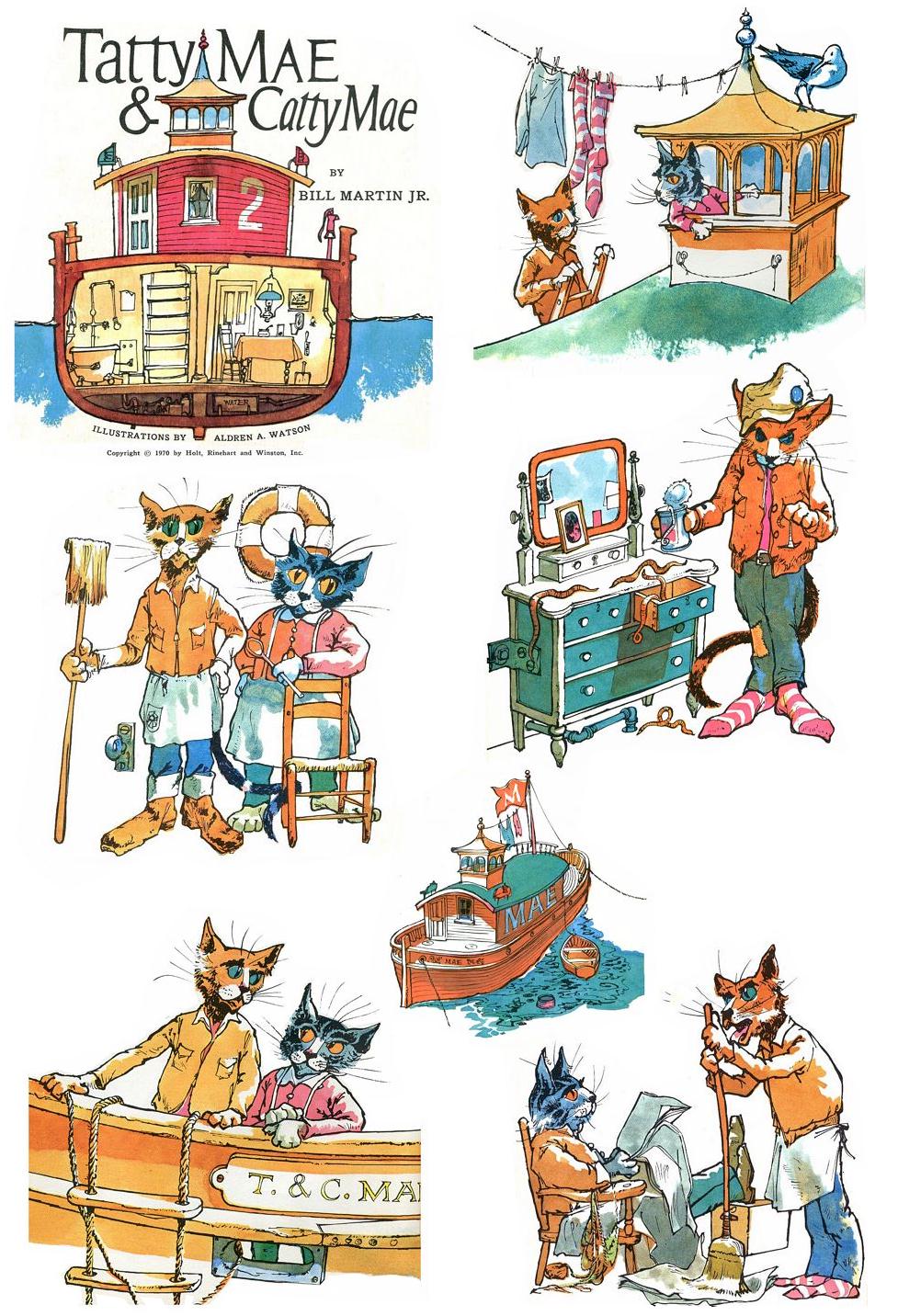
Exorcizing Ghost Lines: Tatty Mae & Catty Mae
Tatty Mae & Catty Mae, 2 female cats who live aboard a picturesque barge in a childrens book written by Bill Martin Jr. and beautifully illustrated by Aldren A. Watson, published by Holt, Rinehart & Winston in 1970. I scanned the cover and whimsical art of Watson for a taste of nautical escapism.

With the exception of images credited to public institutions,
everything on this page is from a private collection.
Please contact Steamboats.com for permission for commercial use.*
All captions provided by Dave Thomson, Steamboats.com primary contributor and historian.
